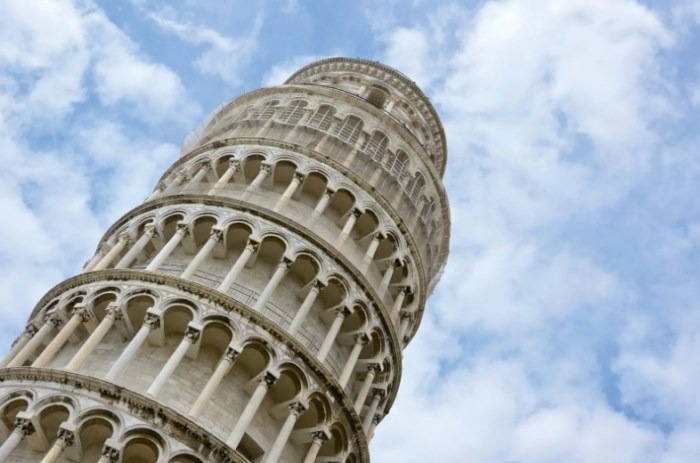Want to visit the iconic Leaning Tower of Pisa Italy? Explore the fascinating history of this Pisa tower, where Galileo conducted experiments. Discover why the Galileo Tower of Pisa remains Italys most famous architectural wonder! Plan your visit today.
Table of Contents
For travel enthusiasts around the world, Italy is a treasure trove of history, culture, and architectural marvels. Among these, the Leaning Tower of Pisa stands out as one of the most iconic and intriguing landmarks. Nestled in the charming city of Pisa in the Tuscany region, this tower is not just a testament to medieval engineering but also a symbol of human curiosity and resilience. In this detailed guide, I will take you through the historical background, cultural significance, natural and human-made landscapes, practical information, and more about the Leaning Tower of Pisa.
Historical Background
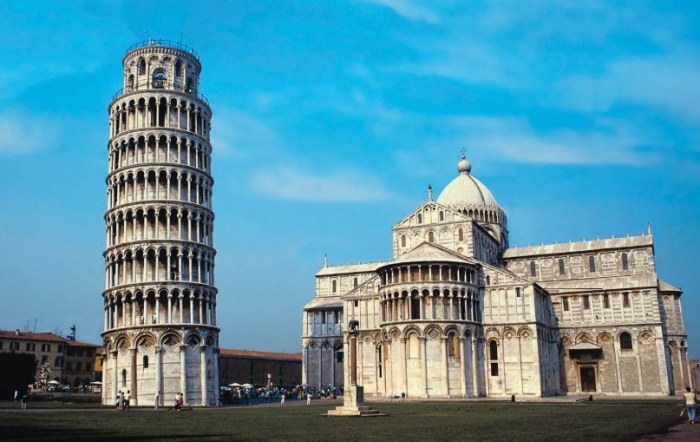
Origins and Construction
The Leaning Tower of Pisa, also known as the Torre Pendente di Pisa, is the freestanding bell tower of the Pisa Cathedral complex. Construction of the tower began in August 1173 and was intended to be a magnificent showcase of Pisas wealth and power during the Middle Ages. The tower was designed by Bonanno Pisano, a renowned architect of the time.
However, the construction process was fraught with challenges. Shortly after the third floor was completed in 1178, the tower began to lean due to the soft ground and inadequate foundation. The sinking of the foundation caused one side of the tower to settle more than the other, resulting in the famous tilt.
Construction Interruptions and Resumptions
The construction of the tower was halted for nearly a century due to a series of wars between Pisa and its neighboring cities, including Genoa, Lucca, and Florence. This pause allowed the ground beneath the tower to settle, which, ironically, may have helped prevent the tower from collapsing during its early years.
Construction resumed in 1272 under the direction of Giovanni di Simone, who attempted to correct the tilt by making the upper floors taller on one side. Despite these efforts, the tower continued to lean. The final touches were added in the 14th century, with the completion of the bell chamber.
Historical Significance
Over the centuries, the Leaning Tower of Pisa has become a symbol of Pisa and Italy itself. It has attracted countless visitors, scientists, and engineers who have studied its unique structure and the physics behind its tilt. The tower has also been the subject of numerous artistic representations, from paintings to photographs, and has even inspired architectural designs around the world.
Cultural Significance
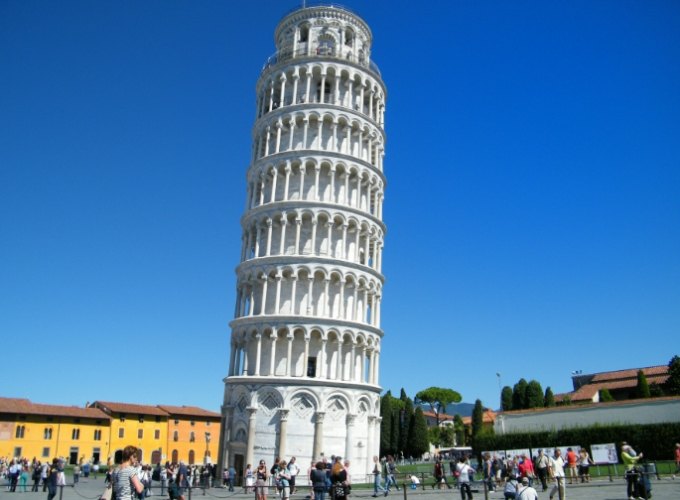
Architectural Style
The Leaning Tower of Pisa is a prime example of Romanesque architecture, characterized by its round arches, thick walls, and decorative arcades. The towers eight stories are adorned with elegant columns, blind arches, and sculpted reliefs, showcasing the skill and craftsmanship of medieval artisans.
Religious and Cultural Importance
As part of the Pisa Cathedral complex, the Leaning Tower holds significant religious and cultural importance. The cathedral, baptistery, and cemetery surrounding the tower are all UNESCO World Heritage Sites, recognized for their historical and architectural value. The towers bells were once used to call the faithful to prayer, and its presence in the cityscape has been a source of pride for the people of Pisa for centuries.
Scientific and Engineering Interest
The Leaning Tower of Pisa has long fascinated scientists and engineers due to its unique tilt. Over the years, numerous studies have been conducted to understand the forces at play and to develop methods to stabilize the tower. In the late 20th and early 21st centuries, extensive restoration work was carried out to reduce the tilt and ensure the towers long-term stability. These efforts have not only preserved the tower but also enhanced its appeal as a scientific and engineering marvel.
Natural and Human-Made Landscapes
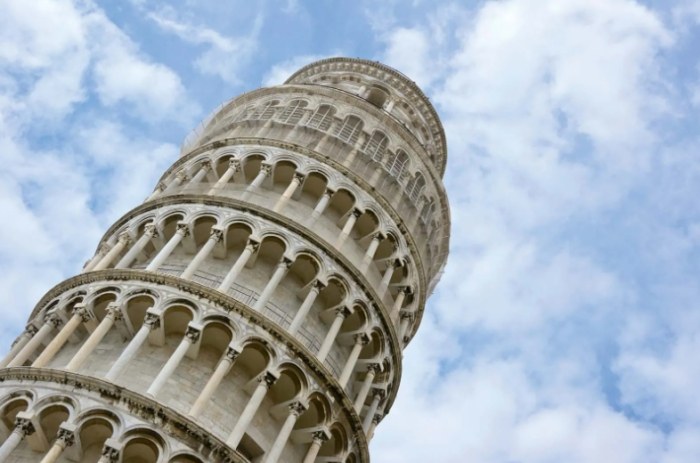
The Piazza dei Miracoli
The Leaning Tower of Pisa is located in the Piazza dei Miracoli (Square of Miracles), a large, open square that is home to several other important buildings. In addition to the tower, the square features the Pisa Cathedral, the Pisa Baptistery, and the Camposanto Monumentale (Monumental Cemetery). The entire complex is surrounded by lush green lawns and gardens, creating a serene and picturesque setting.
Surrounding Architecture and Landmarks
Pisa itself is a city rich in history and architecture. The Arno River flows through the city, offering beautiful views and opportunities for leisurely strolls. The Ponte di Mezzo, a historic bridge spanning the Arno, is a popular spot for locals and tourists alike. Other notable landmarks include the Piazza dei Cavalieri (Knights Square), the Palazzo della Carovana, and the Santa Maria della Spina church.
Scenic Views and Photography Opportunities
The Leaning Tower of Pisa provides excellent photography opportunities, especially during the golden hours of sunrise and sunset. The towers unique tilt against the backdrop of the blue sky or a vibrant sunset creates stunning visuals. Visitors can also capture memorable shots by posing in creative ways, such as "holding up" the tower or pretending to push it back place.
Practical Information
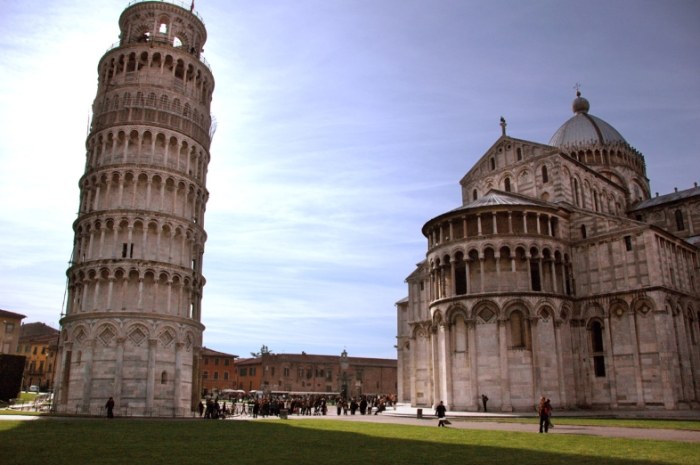
Visiting Hours
The Leaning Tower of Pisa is open to visitors throughout the year, but the opening hours vary depending on the season. Here is a general guide:
- January - February: 10:00 AM - 5:00 PM
- March: 9:00 AM - 6:00 PM
- April - September: 8:30 AM - 8:00 PM
- October: 9:00 AM - 7:00 PM
- November - December: 10:00 AM - 5:00 PM
It is advisable to check the official website or contact the ticket office for the most up-to-date information, as hours may be subject to change due to special events or maintenance.
Ticket Prices
Tickets to the Leaning Tower of Pisa must be purchased in advance, as access is limited to ensure the safety of visitors and the preservation of the monument. Ticket prices vary depending on the type of ticket and the time of year:
- Standard Ticket: €18 (includes access to the tower and the other monuments in the Piazza dei Miracoli)
- Reduced Ticket: €10 (available for children aged 8-18, students, and seniors over 65)
- Free Entry: Children under 8 years old, disabled visitors, and their caregivers
Tickets can be purchased online through the official website or at the ticket office on-site. It is recommended to book tickets well in advance, especially during peak tourist seasons, to avoid disappointment.
Transportation Routes
Getting to the Leaning Tower of Pisa is relatively easy, as Pisa is well-connected by various modes of transportation:
- By Air: Pisa International Airport (Galileo Galilei Airport) is the main airport serving the city. From the airport, visitors can take a shuttle bus, taxi, or train to the city center.
- By Train: Pisa Centrale is the main railway station, with frequent connections to other major Italian cities such as Florence, Rome, and Milan. From the station, visitors can take a short walk or a bus to the Piazza dei Miracoli.
- By Bus: Several bus lines connect Pisa with nearby towns and cities. The LAM Rossa bus line stops directly at the Piazza dei Miracoli.
- By Car: If driving, visitors can park in one of the several parking lots near the Piazza dei Miracoli. However, due to limited parking spaces and high demand, it is advisable to use public transportation if possible.
Best Time to Visit
The best time to visit the Leaning Tower of Pisa depends on personal preferences and the type of experience you are seeking:
- Spring (March - May): Spring is a pleasant time to visit, with mild temperatures and blooming flowers. The city is less crowded compared to the summer months, making it easier to explore at a leisurely pace.
- Summer (June - August): Summer is the peak tourist season, with warm weather and long days. However, the city can be crowded, and lines for the tower may be longer. It is advisable to book tickets well in advance and arrive early to avoid the heat and crowds.
- Fall (September - November): Fall is another great time to visit, with cooler temperatures and fewer tourists. The changing leaves add a touch of color to the cityscape, creating a picturesque setting.
- Winter (December - February): Winter is the low season, with fewer visitors and cooler temperatures. While the weather may be colder, the city has a quiet charm, and visitors can enjoy the monuments without the crowds.
Special Events and Activities
Throughout the year, Pisa hosts several special events and activities that add to the citys vibrant atmosphere:
- Luminara di San Ranieri: Held annually on June 16th, this festival commemorates the citys patron saint, San Ranieri. Thousands of candles are lit along the Arno River and in the streets, creating a magical ambiance.
- Gioco del Ponte: Taking place in late June, this historic reenactment features teams from different districts of Pisa competing in a tug-of-war over the Arno River. The event is a colorful spectacle and a great opportunity to experience local traditions.
- Christmas Markets: During the holiday season, Pisas Piazza dei Cavalieri and other squares are transformed charming Christmas markets, offering festive treats, handicrafts, and entertainment.
Accommodation Recommendations
Pisa offers a wide range of accommodation options to suit different budgets and preferences. Here are some recommendations:
Luxury Hotels
- Hotel Relais dellOrologio: Located in the heart of Pisa, this boutique hotel offers elegant rooms, a rooftop terrace with panoramic views, and personalized service.
- Grand Hotel Duomo: Situated just steps away from the Leaning Tower, this historic hotel features luxurious rooms, a gourmet restaurant, and a spa.
Mid-Range Hotels
- Hotel Bologna: A charming hotel located near the Pisa Centrale railway station, offering comfortable rooms, a restaurant, and easy access to the citys attractions.
- Hotel La Pace: Situated in a quiet area of Pisa, this hotel provides spacious rooms, a swimming pool, and a garden, making it a great choice for families.
Budget-Friendly Options
- Hostel Pisa Tower: Located near the Leaning Tower, this hostel offers dormitory-style and private rooms, a shared kitchen, and a lively atmosphere.
- B&B Il Campanile: A cozy bed and breakfast situated in the historic center, providing comfortable rooms, a delicious breakfast, and friendly hosts.
Culinary Delights
No visit to Pisa would be complete without sampling the local cuisine. Tuscany is renowned for its hearty dishes, fresh ingredients, and excellent wines. Here are some must-try foods and restaurants:
Traditional Tuscan Dishes
- Ribollita: A thick, hearty soup made with bread, beans, and vegetables, typically served with a drizzle of olive oil.
- Bistecca alla Fiorentina: A thick, grilled T-bone steak, often seasoned with salt, pepper, and olive oil, and cooked to perfection.
- Pappa al Pomodoro: A tomato and bread soup, flavored with garlic, basil, and olive oil, perfect for a light lunch or starter.
- Cantucci: Almond biscuits traditionally served with Vin Santo, a sweet dessert wine.
Recommended Restaurants
- Osteria dei Cavalieri: Located in the Piazza dei Cavalieri, this restaurant offers a cozy atmosphere and a menu featuring traditional Tuscan dishes.
- La Ginestra: Situated near the Leaning Tower, this family-run restaurant is known for its homemade pasta, fresh seafood, and friendly service.
- Gelateria De Coltelli: For a sweet treat, head to this gelateria, which offers a wide variety of flavors, including classic Italian options like pistachio and stracciatella.
Tips and Precautions
To make the most of your visit to the Leaning Tower of Pisa, here are some tips and precautions to keep in mind:
- Book Tickets in Advance: As mentioned earlier, tickets to the tower must be purchased in advance. Booking online ensures a spot and saves time on-site.
- Dress Appropriately: When visiting religious sites, such as the Pisa Cathedral, it is important to dress modestly. Shoulders and knees should be covered.
- Be Mindful of Pickpockets: Like any popular tourist destination, Pisa can attract pickpockets. Keep your belongings secure and be aware of your surroundings, especially in crowded areas.
- Stay Hydrated: Pisa can get hot, especially during the summer months. Carry a water bottle and stay hydrated, especially if you plan to spend a lot of time outdoors.
- Respect the Monuments: The Leaning Tower of Pisa is a precious historical monument. Follow the rules and guidelines provided by the staff, and avoid touching or leaning on the tower.
Q&A
1. Why is the Leaning Tower of Pisa famous?
The Leaning Tower of Pisa is famous for its unique tilt, which has made it one of the most recognizable landmarks in the world. The towers construction began in 1173 but was halted due to the soft ground causing it to lean. Despite efforts to correct the tilt during construction, the tower continued to lean, eventually becoming a symbol of human ingenuity and resilience. Over the centuries, the tower has attracted countless visitors, scientists, and artists, and has been featured in numerous works of art, literature, and film.
2. Can you still visit the Leaning Tower of Pisa?
Yes, the Leaning Tower of Pisa is open to visitors, and climbing to the top is a popular activity. However, access to the tower is limited to ensure the safety of visitors and the preservation of the monument. Tickets must be purchased in advance, and visitors are required to follow a specific route and adhere to safety guidelines. The climb to the top involves 294 steps, and the views from the top are truly breathtaking.
3. How is the Leaning Tower of Pisa leaning without falling?
The Leaning Tower of Pisa has been leaning for centuries due to the soft ground and inadequate foundation. However, it has not fallen because the tilt has been gradual, and the towers design and construction have helped distribute the weight evenly. Over the years, engineers have taken measures to stabilize the tower, including removing soil from beneath the higher side and installing counterweights. In the late 20th and early 21st centuries, extensive restoration work was carried out to reduce the tilt further and ensure the towers long-term stability.
4. Is the Colosseum near the Leaning Tower of Pisa?
No, the Colosseum is not near the Leaning Tower of Pisa. The Colosseum is located in Rome, Italys capital city, while the Leaning Tower of Pisa is situated in the city of Pisa, in the Tuscany region. The two landmarks are approximately 300 kilometers apart by road, making it a long journey to visit both in a single trip. However, both are must-see attractions for anyone interested in Italian history, culture, and architecture.
In conclusion, the Leaning Tower of Pisa is a must-visit destination for any travel enthusiast. Its rich history, cultural significance, and unique architecture make it a truly unforgettable experience. By following the tips and information provided in this guide, you can make the most of your visit to this iconic landmark and create memories that will last a lifetime.
About the author:I’m Frank, the traveler and foodie behind Italy Travel Guide. For over a decade, I’ve been exploring every corner of Italy—from the canals of Venice to the lemon groves of the Amalfi Coast—sharing the best hidden gems, authentic trattorias, and charming boutique hotels along the way. My passion? Helping you experience Italy like a local, whether that means finding the perfect tiramisu in Florence, navigating Italy’s train system like a pro, or uncovering that tiny family-run vineyard in Tuscany. Join me as we dive la dolce vita, one unforgettable adventure at a time!
